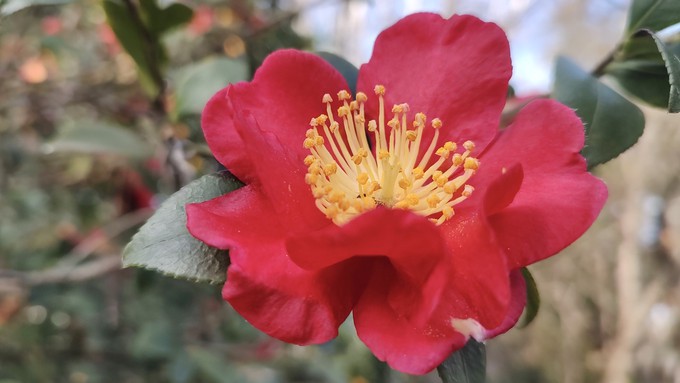
'Yuletide' brightens holidays, feeds hummingbirds with December blooms

'Yuletide' is an appropriate name for this red sasanqua camellia. Debbie Arrington
What’s the perfect flower for Sacramento’s holiday season? My vote goes to the Christmas camellia.
After all, we are the Camellia City and Camellia sasanqua dependably blooms every December – and then some. These camellias also are tough, drought-tolerant and can thrive for decades with little care.
With distinct golden centers, these camellias started opening locally in October. Due to mostly mild weather conditions, they’ve stuck around for more than six weeks and still look good for the holidays.
As a Christmas cut flower, sasanqua camellias are attractive in a vase or bowl. They’re also intensely fragrant and brighten up a room with their scent and color. As a potted plant, they make a thoughtful garden gift.
My three Christmas camellia bushes are at least 40 years old; they were planted when our home was built in 1980 and still going strong. They’re all 'Yuletide,' a variety first introduced by Nuccio’s Nurseries in Altadena in 1963. With distinctive large single red blooms, Yuletide was registered with the American Camellia Society.
My 8-foot Yuletide bushes right now are covered with dozens of big red blooms, each 4 to 5 inches across. The flowers almost glow against their shiny green foliage – a natural holiday combination.
In the early winter garden, Christmas camellias make the greatest impact. Besides looking fantastic, they support beneficial wildlife. Those pretty flowers feed bees and hummingbirds when few other flowers are available. This month, I’ve enjoyed watching the hummers feast on my Yuletides.
Sasanqua camellias bloom two to three months before their close cousins, japonica camellias, which start appearing in February. With natural hardiness, Christmas camellias can thrive in spots where japonicas struggle. They can tolerate drought conditions and colder temperatures. Although they prefer filtered shade or dappled sunlight, Christmas camellias also can take more full sun than japonicas.
Cold, hard rain will bring an end to Christmas camellia season, usually in early January. That’s when they’ll start dropping their flowers in bunches. Pick up and dispose of those fallen flowers to help prevent petal blight, a fungal disease that turns camellia petals prematurely brown. Otherwise, those spores will hang around and infect the japonica camellias as they open.
As landscape plants, Christmas camellias are long-lived (often several decades) and easy care. After flowering, they need little if any pruning; just remove dead wood and gently shape if necessary.
Then, feed sasanqua bushes with an acid-type fertilizer formulated for camellias, which prefer slightly acid soils.
But don’t feed your japonica camellias until after they finish blooming in March. Feeding while camellias are in bloom (or about to bloom) may cause them to drop unopened buds.
Thinking about a gift plant? Christmas camellias can be found in bloom now in local nurseries. These bushes can be transplanted after they finish bloom and will continue to bring smiles for many years to come.
For more about growing camellias locally: https://www.camelliasocietyofsacramento.org/
More on camellias:
Comments
0 comments have been posted.Sacramento Digs Gardening to your inbox.
Sites We Like
Garden Checklist for week of May 5
Survey your garden after the May 4 rainstorm. Heavy rain and gusty winds can break the neck of large flowers such as roses. Also:
* Keep an eye on new transplants or seedlings; they could take a pounding from the rain.
* Watch out for powdery mildew. Warmth following moist conditions can cause this fungal disease to “bloom,” too. If you see a leaf that looks like it’s dusted with powdered sugar, snip it off.
* After the storm, start setting out tomato transplants, but wait on the peppers and eggplants (they want warmer nights). Pinch off any flowers on new transplants to make them concentrate on establishing roots instead of setting premature fruit.
* Trim dead flowers but not leaves from spring-flowering bulbs such as daffodils and tulips. Those leaves gather energy to create next year's flowers. Also, give the bulbs a fertilizer boost after bloom.
* Pinch chrysanthemums back to 12 inches for fall flowers. Cut old stems to the ground.
* Mulch around plants to conserve moisture and control weeds.
* From seed, plant beans, beets, cantaloupes, carrots, corn, cucumbers, melons, pumpkins, radishes and squash.
* Plant onion sets.
* In the flower garden, plant seeds for asters, cosmos, celosia, marigolds, salvia, sunflowers and zinnias. Transplant petunias, zinnias, geraniums and other summer bloomers.
* Plant perennials and dahlia tubers for summer bloom.
* Don’t wait; plant summer bulbs, such as gladiolus and tuberous begonias.
* Harvest cabbage, lettuce, peas and green onions.